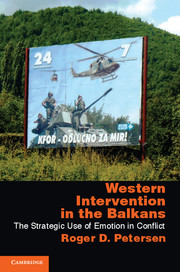Book contents
- Frontmatter
- Contents
- Acknowledgments
- Part 1 Background and Theory
- Part 2 Cases and Tests
- 7 Background to Western Intervention in the Balkans
- 8 The Case of the Roma in Kosovo
- 9 Background to Kosovo
- 10 Waiting for the West
- 11 Kosovo Intervention Games, I
- 12 Kosovo Intervention Games, II
- 13 Kosovo Conclusions
- 14 South Serbia
- 15 Macedonia
- 16 Bosnia
- 17 Montenegro
- 18 Conclusion
- Appendix A A Note on Names
- Appendix B Alternative Arguments
- References
- Index
- References
8 - The Case of the Roma in Kosovo
from Part 2 - Cases and Tests
Published online by Cambridge University Press: 05 June 2012
- Frontmatter
- Contents
- Acknowledgments
- Part 1 Background and Theory
- Part 2 Cases and Tests
- 7 Background to Western Intervention in the Balkans
- 8 The Case of the Roma in Kosovo
- 9 Background to Kosovo
- 10 Waiting for the West
- 11 Kosovo Intervention Games, I
- 12 Kosovo Intervention Games, II
- 13 Kosovo Conclusions
- 14 South Serbia
- 15 Macedonia
- 16 Bosnia
- 17 Montenegro
- 18 Conclusion
- Appendix A A Note on Names
- Appendix B Alternative Arguments
- References
- Index
- References
Summary
I begin the empirical section with a brief account of the Roma in Kosovo. Although the Roma case in Kosovo is a depressing one and significant on its own merits, the Roma in Kosovo were not a large group, nor were they the primary players in the conflict there. Given the desire to avoid the ethnic stigma involved with being a Rom and the incentives not to declare oneself a Rom in the census, it is difficult to get a good estimate of how many Roma have lived in Kosovo. In the last reliable prewar census of Kosovo in 1981, Roma tallied 34,126 out of a population of approximately 1.5 million. NGOs and Roma organizations have produced numbers of up to 200,000. The OSCE and Save the Children give a figure of 100,000 to 150,000 for Roma, Ashkali, and Egyptians combined. These numbers are not high, and the Roma case is an outlier in some ways. However, outlier cases sometimes illustrate social and political phenomena in a stark way. I begin with the Roma case to isolate the workings of contempt and hatred, which will be seen in more complexity and detail in the Albanian–Serb case that follows. In addition, the case highlights the West's problems in dealing with these emotions.
Ciganska mahala, mitrovica
In August of 2006, an NGO representative took me on a tour of what used to be Ciganska Mahala, or the Roma quarter of Mitrovica. I say “used to be” because there was absolutely nothing left of the old district. Prior to the summer of 1999, more than 8,000 Roma were official residents of a compact neighborhood on the south bank of the Ibar River. It was one of the largest, most stable and least poor Roma communities in all of Europe and covered no less than 10–12 hectares of land. The mahala contained large family compounds as well as lesser dwellings. In 2006, only a few skeleton-like remains of some brick chimneys dotted the landscape, the rest destroyed in the aftermath of the 1999 NATO bombing campaign.
- Type
- Chapter
- Information
- Western Intervention in the BalkansThe Strategic Use of Emotion in Conflict, pp. 130 - 136Publisher: Cambridge University PressPrint publication year: 2011



